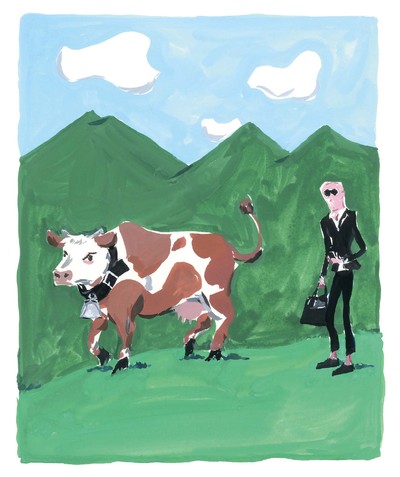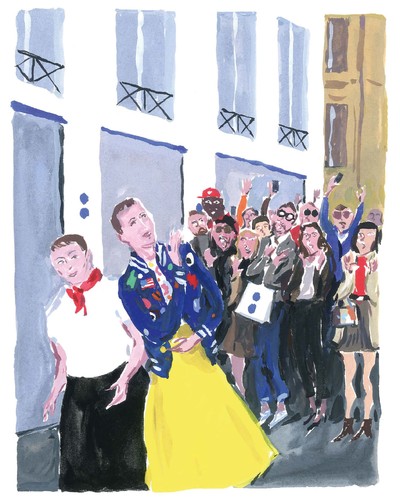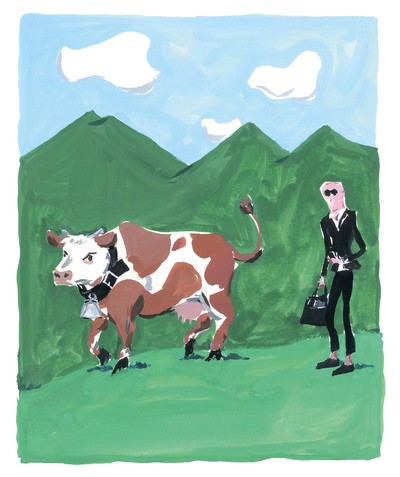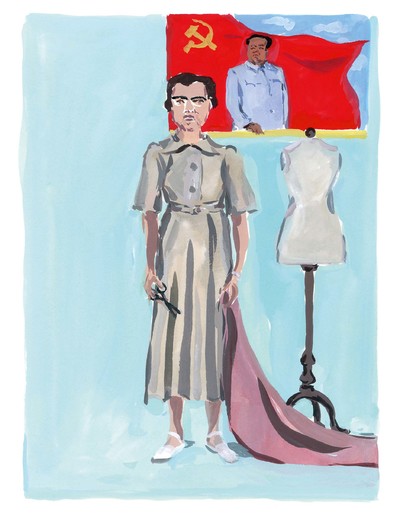By Sarah Andelman
Matthew Schneier
Hung Huang
Illustrations by Jean-Philippe Delhomme


colette: past, present and future
Some people thought I would move to Woodstock after closing colette. After all there’s still so much to discover in the region. Like Hobart, a town I just found out has seven bookshops for 600 inhabitants! I love our ‘second home’ in the Catskills, but I still can’t imagine living here full-time. Would I appreciate the sky, the flowers, the river in the same way if they were part of my quotidien?
Nevertheless, it’s always amazing what you can find when you have a curious and roaming eye – which is what my mother, Colette, has always taught me. And it is a desire to discover and share what’s new that explains much of colette’s 20-year history. But now it’s time for me to turn the page on that past and seek out other expressions of ‘new’. Why now? Simply because it just felt like the right thing to do. It could have been yesterday or next year or in 15 years, but the fact is, we’re content to be announcing our closure at a time when the business is doing well, and the colette story remains pure and untarnished. Of course, we could have sold the name – and the business – on many previous occasions, but colette is tied to a place and to the person whose name it bears.
My mother has worked incredibly hard all her life; she’s been profoundly inspiring to me and many others. Yet only a few people have witnessed first-hand quite how committed she’s been over the past two decades, just how fundamental she has been to the spirit and history of colette. But now it’s time for her to take a step back, to adjust to a different rhythm of life, even though her curiosity will always remain.
As for me, this past fashion week has been the first in over 20 years that I’ve not had to run around like crazy, placing orders. My first instinct, when discovering the work of a young designer or a new magazine or an original-looking skateboard, has always been to place an order and share those things in colette. Not having that outlet is a big change for me. But it won’t stop me continuing to support creative talents, however I can.
In Paris, I recently went to an event honouring the late Pierre Bergé. Dominique Deroche – who spent much her life working with Monsieur Bergé and Yves Saint Laurent – took the time to speak to me, kindly commenting that everything we did at colette was éblouissant: ‘dazzling’ or ‘magnificent’. Coming from a woman who collaborated so closely with Monsieur Saint Laurent, it was powerful and meant a lot. But then Dominique has always been wonderful to me. It was 1998 when I first went to her office – unbelievably! – to ask to stage an exhibition at colette of Saint Laurent’s La Vilaine Lulu drawings. I know that in later years Monsieur Bergé (somewhat) distanced himself from the brand he’d given his life to, but I wish he was still around to witness the approaching transformation of colette into Saint Laurent.
The last day of colette will be December 20th. As much as I want it to be a regular working day, I know it’ll be a combination of intense personal emotion and the madness of the crowded space. We’ve already witnessed incredible scenes just these past few weeks: people in tears telling us how much colette has meant to them; a gay couple who came in to tell us they’d named their child colette, after the store.
It is too early to tell what history will make of colette. It’s not something I can control, and I have no desire at the moment to mythologize a project that’s always been about the present and future, even though I’m as fascinated as anyone by the mythology of historical places such as Biba. As things stand, the legacy of colette – if there is one – is of a place where we brought people together and made things happen. It’s always been about creating a place where everyone can come and where everything is possible.
And that’s where I see my future: continuing to ‘make things happen’. Staging exhibitions, projects and collaborations, but also working directly with brands or channels, perhaps. And as long as the work retains the same freedom and openness to which I’ve become accustomed at colette, it could be anyone – a young designer, a huge brand like Coca-Cola, a car manufacturer. Because as I’ve learned these past 20 years, with a curious eye, anything is possible.

For whom the cow bells toll.
On October 4th, after 30 or so days of looking – continuously, nearly unblinkingly – at fashion and fashion shows, I woke up early, groggy, sour, and went to see the cows. They were skinny, brindled things, more like dogs than heifers, and they had outfits, or at least, accessories: bells around their necks that clanged in warning when they walked. They sounded like church bells in miniature.
I had come to escape. I was by a field in an obscure canton of German-speaking Switzerland, where the locals talk in a dialect unintelligible even to Swiss German speakers, fry veal sausages and go about their business well insulated from what we euphemistically call the ‘fashion world’. A multibillion dollar business that in recent years has mutated into something combining the best and worst parts of commerce, blockbusters and bullshit. I am (luckily, I might add) part of an odd, sizable caravan whose job it is to follow the circus and report what goes on there to those who are interested. It’s a job I found my way into without intending to, but found myself enraptured by an industry that exists at the nexus of so many fascinating vectors, often working against one another. I love commerce. I love blockbusters. Properly delivered, I love bullshit.
As fashion has moved from the elite privilege of the cloistered few to mass entertainment on a Hollywood scale, more people are interested in it than ever, and accordingly, there is more need to interest them. So the shows have become richer, stranger, with musical acts and set pieces and sponsored starlets sitting front row. More than anything else, there just seems to be more of everything: more brands and more shows and more insistence on giving them your full attention. The scale and the scope have become dizzying, the language used to describe them more hyperventilated. We’re obsessed and we need and we must have and we love. (I am guilty, guilty, guilty, guilty.)
Despite the alarming bounty, there is also a nagging feeling of alarming sameness, ideas ricocheting from one collection to the next, sequential tiles in an endless Instagram scroll. (If Instagram has made it easy for everyone to imbibe one another’s lives, loves and ideas, it also makes it easy for upstarts like Diet Prada to call out serial offenders.) Every collection seems enslaved to the idea of a millennial shopper, so every collection now includes a high-end sneaker, a logo T-shirt, a flirty, whiplash mix of ‘street’, ‘sport’ and ‘haute’.
What brought me to Switzerland was a creeping feeling that the fashion circuit has become alarmingly closed; that fashion people, such as we are, do fashion things, talk fashion talk, chew over the same small handful of references like cud, and retire home to do it all again. Half the people leaving Paris Fashion Week seemed to be headed to Frieze, and half seemed to be headed to a Supreme store opening in Brooklyn. I headed to a Swiss hotel with a more than passing resemblance to a sanatorium. I don’t say this to brag; St Moritz this was not. I dined on health mush and hot cheese; I was the youngest guest by a decade at least. The Blue Room outside of which a strings-and-piano duo in formalwear played every night had not been redecorated since 1908. Every morning, print copies – imagine, print copies of a newspaper! – of the Neue Zürcher Zeitung waited, relaxing in a language I cannot read.
It was profoundly, restoratively un-fashion. Everyone wore unstylish skiwear and sipped thin red Swiss wine in the cold open air by the third-rate golf club. (The Swiss consume most of the wine they produce and export very little; you are not likely to see it on the wine list of any fashionable place any time soon.) Reprieved from the obligation to obsess, to notice every shoe (and the fact that no fewer than three of your international colleagues are wearing it at any one time), I relaxed. I didn’t realize how sensitive my antennae had become, nor how tense I had gotten from holding them aloft at all times. I straightened up from my front-row defensive crouch. I rode a bike (terrifying). I petted a cow.
Maybe you knew this all already. Maybe you don’t need to be reminded to unplug by someone recently converted to the lifestyle of a Swiss convalescent in the years preceding World War I. (Please prepare yourself for my forthcoming lifestyle brand.) But fashion will wait. I blame no one for sheltering in it as a distraction and a refuge, especially at a time when it seems as uncertain of its own future as at any time I can recall (retail is hobbling, magazines are shuttering, ‘the system is broken’, the lifers mutter as they head off for their town cars).
But to obsess without end won’t save it, or us. What we may need – in my own, single, humble opinion – is to go farther from the trail, to be braver, stranger, less slavish in our devotion to our obsessions and less terrified of our deviations, and to return the better for it. So I did. I left in my overnight bag the high-end sneaker and the logo tee. I asked not for whom the cowbell tolls. It tolls for me, and thee.

Fashion memory lane
I am Chinese – at least, I was born Chinese, in 1961. That year, wearing a dress was all the rage. Especially the boo-la-gee, which was how we pronounced платье, the Russian word for dress. This one in particular was a shirt-dress – with button fastenings on the top half, just like a shirt, and a gathered skirt from the waist. This is my first fashion memory. My grandparents used to take me to the parks around Tiananmen Square, and I remember all the girls in their boo-la-gee twirling around to see whose skirt could make a bigger shadow in the sun.
By the time I was in primary school in 1968, the Cultural Revolution was in full swing and no one was wearing a boo-la-gee anymore; it had become the wardrobe of the ‘stinking Soviet revisionists’. The fashion became instead to get army-surplus clothes and pin as many Mao badges on them as possible. When I was in first grade, small Mao badges were in, but they grew bigger and bigger until eventually our baggy uniforms were weighed down with them. Those were crazy years, with midnight parades to celebrate a new speech from the Chairman, and loudspeakers blasting his latest quotes, with everyone marching in their Mao-badge-pinned uniforms. It was like North Korea is now.
By the time I was sent to boarding school in 1970, Mao badges were ‘so last season’, but army surplus was still all the rage. Particularly the real deal, which you could tell apart from replicas with the badges. The real ones had special badges. The cool kids in my class were army brats, with real uniform hand-me-downs from their fathers.
In 1973, I was sent to New York by the Chinese government to study English. To show my staunch patriotic stance, I was determined to wear my army greens over there. But I was told that Westerners already thought the Chinese were poor, so we should get extremely dressed up to show them how well-off China really was. Twenty-eight of us were sent to different countries, and we all received a huge clothing stipend. We made fancy suits for ourselves. I remember getting a dark-red pleated skirt and a light-blue woollen coat.
Unfortunately, the most awkward things on our first day at the Little Red School House were our crisp new suits and patent-leather shoes. I swear we would have fitted in better in our army surplus, so we quickly ditched the fancy clothes and ran to The Gap for our first pair of jeans. Mine weren’t jeans, though. Instead, I got two pairs of corduroy bell-bottom pants – one in burgundy, one in sky blue.
While I was strutting around in bell-bottoms in Greenwich Village, fashion was changing at home. Jiang Qing, Mao’s wife tweaked the Russian dress, giving it an empire waist and making it pleated instead of gathered, and swapping the button-front for a Chinese crossover fold. She was very proud of her design, apparently. My mother, the wife of the foreign minister in the 1970s, was called to visit Mao’s wife at two in the morning. “I designed a dress!” Madame Mao ecstatically told her and three other sleepy ministers’ wives.
My mother recalled later that Jiang Qing wanted all foreign ministry personnel to wear the dress, and that my mother and the other wives had to wear it as an example for others. She said that even though it was the middle of the night, tailors were on standby to cut the dresses immediately. ‘Did you wear it?’ I asked her. ‘No,’ she said. I asked if it was dangerous not to wear Madame Mao’s dress. ‘Yes,’ she replied, ‘but you have to make a stand somewhere.’
And there it was, my mother’s political rebellion – all tied up in a dress.
After going to America, my fashion memory merged with the mainstream, and it stopped being unique. In the 1980s, Pierre Cardin came to China and introduced Western fashion to the Chinese. In the 1990s, China became the garment factory of the world and Chinese cities were flooded with counterfeits of Western brands. And, with their arrival, Chinese fashion disappeared.